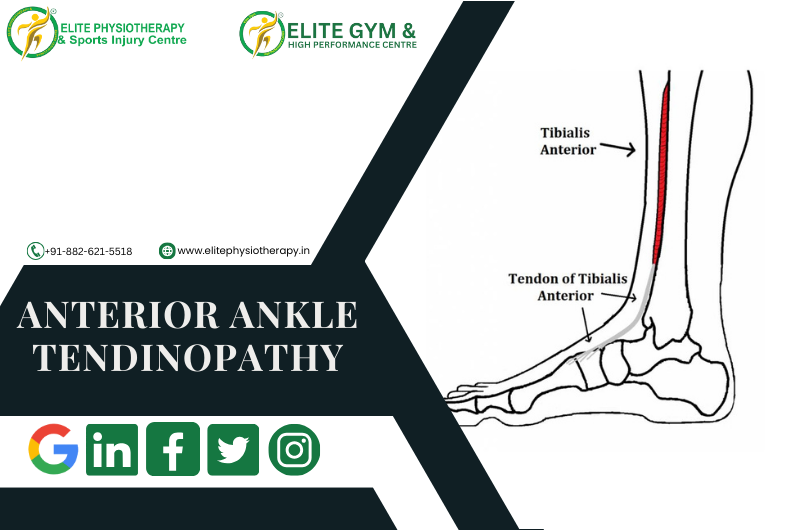Anterior Ankle Tendinopathy
Pain and dysfunction at the front of the ankle are symptoms of anterior ankle tendinopathy, which mostly affects the tibialis anterior tendon. Both daily activities and athletic performance may be greatly impacted by this condition, particularly for those who do repetitive dorsiflexion movements.
Causes and Mechanism of Injury
To dorsiflex the foot and enable upward movement, the tibialis anterior muscle is essential. Microtrauma and tendon degeneration can result from overuse or repetitive strain, especially during activities like jogging or climbing on uneven terrain. People can be predisposed to this tendinopathy by systemic disorders like diabetes or hypertension, as well as intrinsic variables including age-related tendon degradation and diminished vascularity. Mechanical overload, abrupt increases in exercise intensity, and inappropriate footwear are examples of extrinsic variables.
Long-distance runners who abruptly increase their training volume without enough recovery frequently develop anterior ankle tendinopathy. Running-induced repetitive dorsiflexion and inadequate recovery time might overstress the tibialis anterior tendon, causing microtrauma and subsequent tendinopathy.
Signs and Symptoms
Patients typically present with:
- Pain in the medial midfoot and anterior ankle.
- Resistance to dorsiflexion worsens the pain.
- Tenderness along the tibialis anterior tendon’s length.
- Crepitus or swelling in the affected area.
These symptoms may be more noticeable at night and frequently get worse with activity.
Diagnostic Methods at Elite Physiotherapy and Sports Injury Centre
We at Elite Physiotherapy and Sports Injury Centre use thorough physical and functional evaluations to diagnose anterior ankle tendinopathy. Our strategy consists of:
- Clinical Evaluation: a thorough medical history to determine the development of symptoms, activity levels, and possible causes.
- Physical Examination: Palpation along the tibialis anterior tendon to detect tenderness or edema; discomfort assessment using resisted dorsiflexion.
- Special Tests: Orthopedic specialists use particular tests to assess the integrity and function of tendons.
These evaluations enable us to precisely identify the condition and provide a customized therapy strategy.
Physiotherapy Management at Elite Physiotherapy and Sports Injury Centre
In order to prevent recurrence, our facility provides a thorough physiotherapy program that addresses underlying reasons in addition to symptom relief. Among our managerial techniques are:
- Activity Modification: Helping patients cut back on or stop activities that make their symptoms worse so that the tendon can recover.
- Manual therapy: Using methods like massage and soft tissue mobilization to ease tense muscles and increase blood flow to the afflicted area.
- Therapeutic Exercises: Creating customized workout plans to improve the tibialis anterior muscle and its surrounding structures’ strength, flexibility, and endurance.
- High-end modalities: Making use of cutting-edge therapeutic technologies to ease pain and encourage recovery, such as:
- Shock Wave Therapy: Shock wave therapy involves using acoustic waves to promote tendon repair and reduce pain.
- Capacitive Resistive Electric Transfer (CRET) Therapy: Using deep thermal effects, Capacitive Resistive Electric Transfer (CRET) therapy improves tissue repair.
- Super Inductive System: The Super Inductive System uses high-intensity electromagnetic fields to lessen pain and promote tissue regeneration.
- High-Intensity Class 4 Laser Therapy: High-intensity Class 4 laser therapy involves using deep tissue laser therapy to lower inflammation and encourage healing.
- Hydrotherapy: Hydrotherapy involves using water-based exercises to increase strength and mobility while reducing joint stress.
- Cryotherapy: Using cold therapy to alleviate acute pain and inflammation.
Pain and dysfunction at the front of the ankle are symptoms of anterior ankle tendinopathy, which mostly affects the tibialis anterior tendon.
At Elite Physiotherapy and Sports Injury Centre, we’re dedicated to giving our patients individualized care and state-of-the-art treatments so they may reach their performance and wellness objectives.

